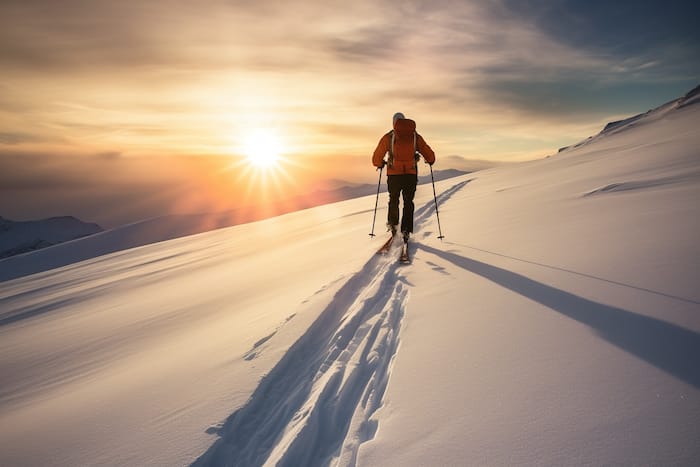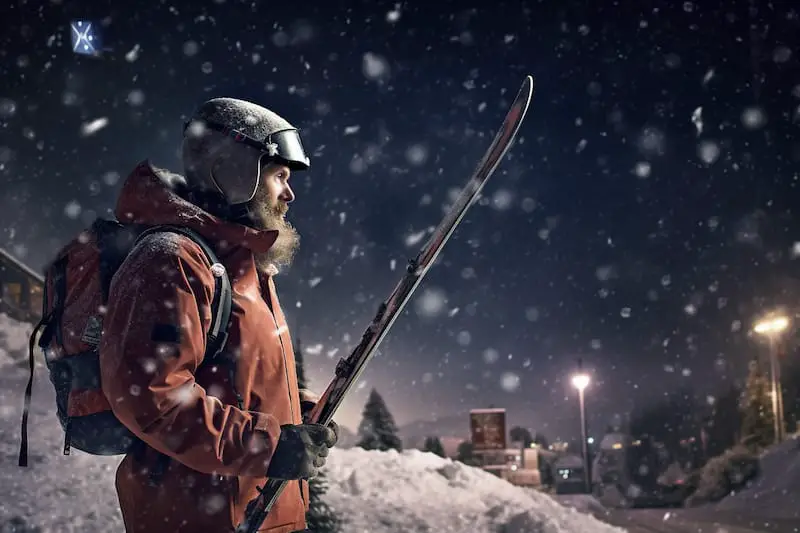Fresh, untouched powder. Challenging terrain. Uncrowded nature. These are just a few of the benefits that come to mind when it comes to the lure of backcountry skiing. Many people who love to ski and do it often search endlessly for these exact types of situations. But is it safe?
Backcountry skiing can be dangerous if you are not prepared. As with most things, preparation is the key to warding off any possible danger that you may encounter. When you take the time to learn a few key safety facts, you can reduce your chances of being injured.
To discover the excitement that comes with backcountry skiing and the dangers that come with it, you will need to know a few things first. Keep reading to learn more about what backcountry skiing is and the dangers you may encounter if you decide to participate.
Can you go skiing with a sprained ankle?
Is Backcountry Skiing Dangerous?
While backcountry skiing can seem exciting, there are also many dangers that can occur. Skiing in these areas is typically frowned upon by authorities and is only meant for those that are more experienced and have some basic knowledge of the area.
Many experts agree that skiing in the backcountry, while exciting, can be a recipe for disaster. This is especially true for those that are inexperienced with either skiing and/or basic awareness of survival skills.
Another reason backcountry skiing is considered potentially dangerous is that many people are not prepared with a basic knowledge of first aid knowledge. This can be life-threatening in many cases, depending on the level of injuries that may occur.
Read about protecting yourself from windburn.
What are the Dangers of Backcountry Skiing?
When it comes to backcountry skiing, many potential disasters can await even the most seasoned skier. In many cases, even those that are prepared with knowledge and equipment have the chance of running into dangerous situations.
While most people who ski know that temperatures can get cold up on the mountains, backcountry skiers should be prepared for unprecedented temperatures. This can make the temperatures seem colder, especially if you are not prepared for the amount of time you will be in the weather conditions.
Traversing in areas that are not well known can be dangerous for those who are not equipped with items such as a compass or other types of GPS equipment. Because of this, many people run the risk of getting lost. If this happens in the backcountry, there is a possibility that it will take quite a while for you to be found, if at all.
Read if you can ski while drinking.
Many people who decide to take the chance in the backcountry fail to check the weather reports before taking the adventure. This can lead to many dangerous situations, such as the possibility of getting caught in a snowstorm. If you are not prepared with the right clothing and equipment, it can have life-threatening consequences.
The most dangerous of all situations you can run into while skiing in the backcountry is the potential for avalanches. In many cases, especially if you are not prepared, an avalanche can end with fatal consequences.
Safety Equipment to Stay Safe When You Ski the Backcountry
Backcountry skiing requires prior planning and specific equipment to maximize your safety on the slopes. You and everyone in your group should gear up with the following items:
- Appropriate clothing: Dress in layers and be sure to wear a hat, gloves, and ski boots
- Avalanche transceiver: The transceiver sends a signal that a rescuer can pick up to help guide them to your location (Check it out here)
- Avalanche shovel: A foldable snow shovel will help test snow conditions and dig out you or another skier should you be trapped (Check it out here)
- Avalanche probe: A probe is a collapsible stick poked into the snow to find someone buried by an avalanche or tree well (Check it out here)
- Avalanche airbag: Useful, but not an absolute necessity, the avalanche airbag can be opened with a ripcord. It inflates to help you rise to the top during an avalanche (Check it out here)
What Are Some Safety Facts You Should Know About Backcountry Skiing?
As with most dangerous sports or adventures, you need to be aware of specific safety measures you can take if you decide to backcountry ski. While many of these facts seem like common sense, there are some that you might not have thought were vital such as before and during planning.
Before You Plan Your Adventure
There are many things that are important to have in place before you take off on your backcountry adventure. Many of these can potentially save your life or the lives of other members of your group.
Anyone who plans to go skiing in the backcountry should have taken an avalanche safety course. In this course, you will learn basic facts about avalanches, signs in the snow you should look for, and what to do if you get caught in one.
Another important factor you should consider when planning your trip is to create a safety plan with the members of the group that are participating. This is because having a plan in place is the best way to be prepared for any situation that may arise.
Many people say that information is your best resource when planning anything in life. Doing the appropriate amount of research about the area you are going to ski in is vital. This research should include previous avalanche information and any dangers you may encounter.
Having the proper equipment is another way to ensure you are prepared for any circumstance that you may come across. Items to include should include plenty of food, water, and clothing. In addition, you should bring along a shovel, basic camping gear, and avalanche transceivers just in case the worst happens.
Planning on going backcountry skiing alone? – Read this
During Your Backcountry Trip
In addition to planning before you leave on your trip to the backcountry, it is also important to be prepared along the way. Making sure you and all the group members are equipped with the proper equipment and knowledge should be the priority.
When it comes to traversing in the backcountry, there are many things that could go wrong. There is very little chance that you and your group will stay together at all times, even though you should try. Ensuring everyone has the proper equipment can be the difference between survival and death.
During your safety preparation before the trip, you and your group should have discussed things such as the environment that you are going into. Everyone should constantly be aware of their surroundings on the off chance that you or someone else should get lost.
Being able to read the terrain you are skiing in is another important key to survival in such dangerous circumstances. If the area does not look safe, it should be avoided at all costs. Additionally, slopes are typically safer when only one person crosses them at a time.
Overall, backcountry skiing can be dangerous if you are not prepared. Knowing the potential dangers and basic safety measures can go a long way to ensuring you and your group members are safe from any danger you may face.






